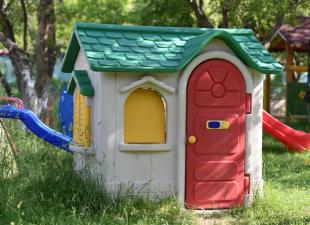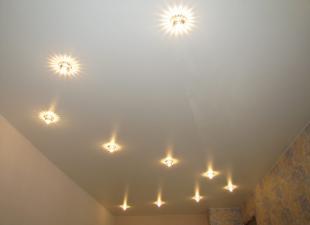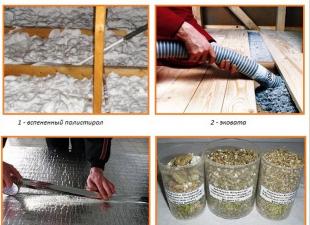A corridor in any apartment or house is an integral part of the premises. Since it is from him that the guests of the apartment begin to form an opinion about the owner, many strive to make this room not only practical and functional, but also beautiful. A great way to give the hallway a twist is to make the floor lighting.
But in order to do everything right, you need to know certain nuances, which our article will tell you about.
Mistress hallway
It is always problematic to make repairs in the corridor, since this room often has non-standard dimensions and is often "broken" by small transitions. The hallway is characterized by the following aspects, which, to a certain extent, can make it difficult to create backlighting:
Corridor option
- small size;
- wrong proportions. in the corridor, you can often find various niches for built-in wardrobes, bends and other architectural nuances necessary to move between rooms;
- narrowness of space. Since the hallway is not intended for a long stay of people in it, but only for their more or less comfortable movement around the apartment, then its width can often skip only one person of average build;
- the problematic design of the backlight.
Note! It is especially problematic to make high-quality lighting in a long and narrow hallway. Tall wardrobes can provide full lighting here.
Therefore, before proceeding with the selection of lighting devices in this room, everything must be carefully thought out and weighed. And for this you need to know what kind of lighting should be present in the corridor to create the required level of lighting in it. This is especially true when you decide to make the floor lighting.
Hallway rules
Floor lighting is a rather non-standard solution, but in recent years it has become increasingly used in the corridor. This is due to many of the nuances of this room, as well as the peculiarities of its architecture.
For your floor lighting to be effective, the following aspects need to be considered:
- luminaires that will be used here as illumination must be reliably protected from dust and moisture. In the hallway, especially in autumn, winter and spring, puddles of mud may appear, flowing down from seasonal shoes. If moisture gets on the luminaires, they may start to work incorrectly or even lead to a short circuit. In addition, wet cleaning, often carried out in the hallway, can also entail the troubles described above. By the way, summer dust from shoes, although it does not have such a catastrophic effect for lighting fixtures, can also negatively affect their work .;
- backlight housing elements must have special mechanical protection. Especially if the distance from the floor to the lighting fixtures is not great;

Luminaire protection
- efficiency of light bulbs. Today in the world there are tendencies towards rational economy and reuse of household items in a new role (the same hand-made, for example). Therefore, many people give preference to modern light bulbs, which can significantly reduce power consumption without losing light characteristics;
Note! At the moment, the most popular are LED lamps and lamps. It is they who have the maximum efficiency, since they consume a minimum of electricity. Installing them will save about 80% compared to a conventional incandescent light bulb.
- another important parameter in the choice of lighting devices is their fire hazard. Luminaires must be made of non-combustible materials, and when exposed to open fire, they must not emit poisonous and dangerous compounds into the air;
- the luminous flux generated by the lamps should not blind the eyes. It is better to choose warm shades, close to the yellow sun color. It is this color spectrum for our eyes that is the most optimal and close to natural light.
Also, quite often, lamps in the corridor at floor level or slightly higher are used to create night illumination of the room. In such a situation, the light emitted by the lighting fixtures should be soft and dim.
A little about saving

Motion Sensor
If you want to minimize the loss of electricity in the house, then to illuminate the floor in the corridor, you must use lighting devices with a built-in motion sensor.
A feature of this kind of products is that they are activated and turn on the light only if the object is moving in the room. In this case, the motion sensor can be configured so that it does not react to pets (cats, dogs, etc.). As a result of the settings, you can improve the ergonomic parameters of the device, excluding its activation when registering an object of small mass or in the presence of a slight movement.
Installing such a sensor will give you the following benefits:
- automation of lighting switching on. In such a situation, you no longer need to fumble with your hand on the wall in search of a switch. This will save your renovation for much longer, and also make moving around the house more comfortable;
- minimization of electricity losses. Since the light will automatically turn on and off only in the presence or absence of movement, you simply will not forget to leave it on.
Today, sensors that react to movement in a given area can be of the following types:
- infrared;
- microwave;
- sound;
- combined.

Types of sensors
The most popular in the house today are infrared motion sensors. It is they who give the minimum number of false inclusions, and are also relatively affordable. In turn, combined models can completely eliminate the risk of incorrect operation due to the presence of two diverse sensors in their composition at once, but they are much more expensive. The rest of the types are most often used for the street, although they can also be found in the house.
Lighting options
As you know, the lighting market is quite diverse at this point in time. But it can also be conditionally divided into six options, which will perfectly fit into the hallway area as a floor lighting:
- Spotlights;
- neon lamps;
- LED strips;
- LED duralight;
- flexible neon;
- light floor.
To understand the features of each backlighting option, we will consider them separately and in more detail.
Spot devices

Spotlights
One of the popular lighting fixtures, often found in the hallway, are spotlights. This is the easiest and most affordable way to organize floor lighting in the corridor. They are built-in appliances, therefore they are installed in specially prepared holes in the side walls or in the floor laminate.
The most optimal option for placing such a backlight would be to install it along the entire perimeter of the corridor. If the room has a wardrobe and other furniture, then such lamps are built in from the side of the free wall.
The advantages of such backlighting include:
- product tightness;
- shock resistance;
- attractive appearance. Such lighting devices can act as an additional decorative decoration of the hallway, which will give it a zest, a special sophistication;
- long period of service;
- the ability to install economical light bulbs.
Separately, it should be noted that these lamps have excellent moisture resistance. Therefore, they will be an ideal option for organizing lighting not only in the corridor, but also in the bathroom and kitchen.
Neon lights
Another classic way to create backlighting is with neon lamps. Such products create an even and soft flowing light.

Neon lamp
The neon lamp itself consists of the following components:
- the lamp itself;
- wires;
- special convector.
Therefore, in this case, only a hidden version of the backlight is allowed, where all the component parts of the device are hidden in a special niche. Neon lamps, just like spotlights, should be placed around the perimeter of the room. As a result, the entire corridor will be flooded with pleasant light.
The advantages of such a backlight include:
- long service life, which will be more than 10 years;
- the presence of a large selection of colors for the backlight;
- pleasant lighting.
But here, in addition to the advantages, there are some disadvantages:
- high fragility of lamps;
- rather high cost;
- the presence of a certain negative effect on the human body.
In addition, it will be problematic to install such a backlight by independent forces. This is where you need professional help. And these are additional costs.
LED strips

LED Strip Light
This type of lighting fixture is as popular as spotlights. Moreover, in a living room or bedroom, they often act in tandem as the main and additional lighting. The same situation is relevant in the case of the hallway. LED strips are energy efficient light sources, which is another reason for their popularity in home lighting.
This lighting fixture consists of the following parts:
- the tape itself;
- power unit;
- remote control and controller (as accessories). With their help, you can create a multi-mode backlight.
Such a light source will be an excellent substitute for neon lamps, fragile and unsafe for human health.
The advantages of ribbons include:
- ease of installation;
- high rates of energy efficiency;
- the presence of an extensive range of colors;
- long period of work;
- the ability to install hidden and non-hidden lighting.
As you can see, the use of LED strip has many advantages.
LED duralight

LED duralight
This lighting fixture acts as an alternative to LED strips and neon lamps. Duralight has the form of a transparent PVC tube, in which LEDs are installed at an equal distance.
The advantages of such a lamp include:
- availability of various colors;
- soft and high-quality lighting;
- the presence of several types of duralight modifications (two- or three-wire).
The design of the luminaire has a plug, with which it is connected to the power supply network.
Flexible neon

Flexible neon
This lighting fixture is a cross between a neon lamp and an LED strip. Its design resembles a duralight: a PVC tube in which LEDs are placed. But the difference is that they emit neon light.
The advantages of such a lamp include the ability to lay it not only along a rectangular area (unlike neon lamps), but also in any other variation. At the same time, everything can be easily done with your own hands without seeking help from a specialist.
Flexible neon has a high uptime (up to 100,000 hours), but it can degrade due to improper use or installation.
Light floor
The term "light floor" means luminous floor modules.

Light floor
Such modules can be installed both in a chaotic manner and around the entire perimeter of the hallway.
The advantages of this option include:
- high moisture resistant properties;
- high shockproof qualities.
With the help of such modules, you can create a special room design. But remember not to overdo it here. Such a floor in several modules is more suitable for a spacious corridor than a narrow hallway.
It should be noted that the light floor is rarely used at home. Most often it can be found in nightclubs and on dance floors, where they act as an element of the dance floor interior.
Conclusion
As you can see, each type of floor lighting has its own characteristics. The lighting of the floor in the corridor should be selected depending on its size, practicality and functionality. In addition, it is necessary to think in advance how effective it will be and how harmoniously it can fit into the existing interior of the hallway. Remember that with the help of lighting (of any type), you can either add charm and originality to the room or completely spoil it.
 parlini.ru Repair of an apartment, a summer residence and a house.
parlini.ru Repair of an apartment, a summer residence and a house.


